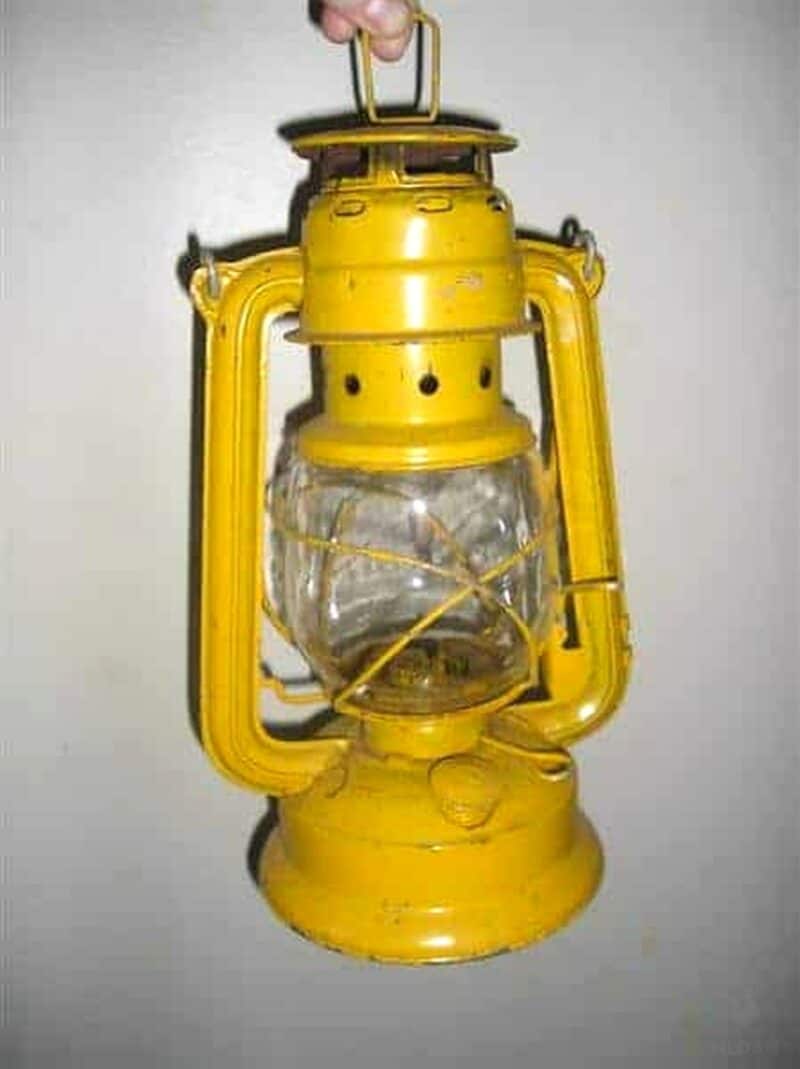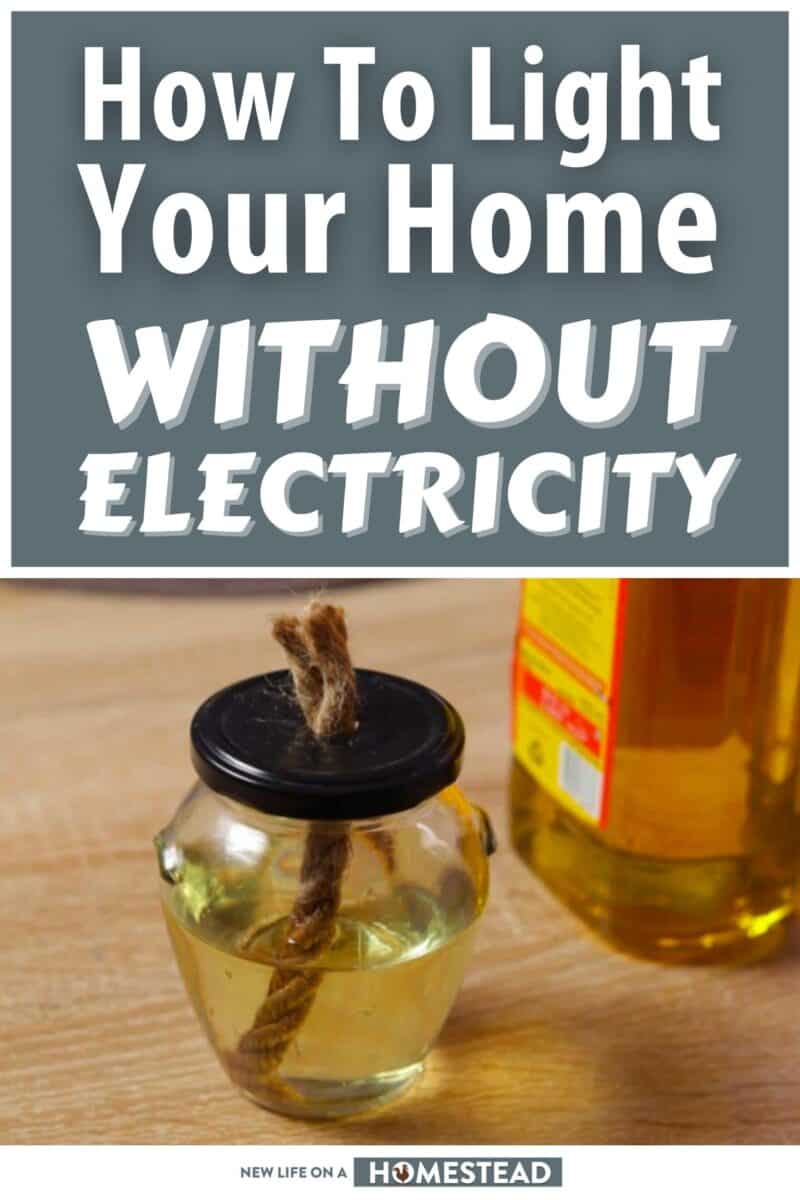In today’s world, it is hard to imagine living without electricity. One of the biggest advantages you’d lose is electric lighting, something most of us take for granted.

But what if there was a long-term power outage and you had to find a way to light your home?
Or what if you were just living a simpler existence off the grid and wanted to reduce your reliance on electricity? Life would go on in either case, and you’d still need light in your home.
Luckily this is something humanity figured out a long time ago, and there are several ways to light your home without reliance on the electrical grid, or using any electricity at all.
In this article, we will discuss several such low-tech lighting techniques that do not use electricity.
Candles
Candles are one of the oldest, and still one of the best, non-electric light sources that you can make use of today.
Versatile, highly adaptable, and generally affordable, candles have extra value for homesteaders because it is easy enough to learn how to make your own once you have a little bit of practice and the right raw materials.
A single candle, as you know, does not put out much light but several of them burning together at strategic locations can light up even a larger room pretty well.
Even one or two candles can light up a small room enough for you to easily navigate and see where you are going.
Another thing to consider is that candles, unlike some other light sources on this list, do put out a small amount of heat and can produce a little bit of smoke.
This is important to consider for overall air quality inside, especially if anyone has respiratory sensitivities, allergies, or other ailments.
Depending on your preferences, you can buy candles made from a variety of materials, everything from paraffin or various natural oil-based waxes to, my favorite, beeswax.
All have advantages and disadvantages concerning burn time, cleanliness, and light produced.
Candles do have some disadvantages, namely the fact that they are completely consumable and useless once used up, and also the fact that they are easily blown out by drafts or gusts of wind if not protected inside an enclosure.
Also, as you should expect, candles are a significant accidental fire hazard because they are an open flame.
If used carelessly they can easily result in a house fire, something you must take care to mitigate. We’ll talk more about that later.
Oil Lamps
Oil-burning lamps have been around nearly as long as candles have, and chances are your great, great grandparents probably use these on a near-daily basis.

Oil lamps have a lot in common with candles, being that they are portable, adaptable, and suitable for various lighting tasks.
A good oil lamp can provide enough ambient light to allow you to get around inside your darkened house or provide bright, direct lighting for various chores and tasks when needed. It is even easy enough to read a book by lamplight.
Depending on the type of the lamp, it might run on kerosene, alcohol, specialty lamp oil, or even have multi-fuel capability, capable of running on more than one dedicated fuel type and even improvised fuels like vegetable or olive oil.
This can make them a tremendous asset for overall preparation or in times of scarcity when your usual fuel is unavailable.
Oil lamps also have the advantage but there are less delicate than candles in general. Though they can be installed directly on walls and ceilings as part of a sconce or chandelier, most are designed to be portable, easy to carry around with a handle, and capable of being set on any convenient, heat-proof surface.
However, like every other light source oil lamps have their own disadvantages. First, compared to candles they require a little more setup to effectively employ and also require maintenance.
Globes need to be cleaned, wicks need to be trimmed and fuel reservoirs will need to be topped off regularly.
Depending on the make, efficiency, and fuel type, oil lamps also produce smoke and other combustion byproducts that can pollute the air quality inside your home without adequate ventilation, and are significantly worse than candles.
Also, any oil-burning lamp represents a tremendous fire hazard if it is damaged or knocked over.
A burning hot wick or element that is suddenly exposed to a ruptured fuel cell or oil spill is likely to erupt into a blazing inferno that you will be hard-pressed to extinguish.
This means that even compared to candles oil lamps must be used with the greatest possible care.
Fireplaces
Probably the most iconic and certainly the most versatile light source on this list is one that you might well have installed in your home already.
Fireplaces pull triple duty as a heat source, a light source, and a way to cook food should it be required if you have the right cookware for the job.
Fireplaces require considerable maintenance and plenty of skill to use effectively and safely but can generate a substantial amount of light for the room that they are in, enough to easily replace other light sources like lamps and candles while they are burning.
Your fireplace might be a traditional, wood-burning one, or it might be a more modern gas burner or artificial log-burning one.
All have advantages and disadvantages, but for our purposes, nothing will top a wood-burning one assuming you have a sustainable supply of firewood that you can make use of.
A gas-burning fireplace can be highly efficient and easy to operate, however, meaning it is viable if you have a large tank on your property that you can depend on.
Obviously, fireplaces can be a substantial accidental fire hazard if not carefully tended, and if chimneys are not maintained they compose a substantial risk of starting a house fire or even trapping hazardous gases inside your living space.
Probably the single biggest disadvantage of a fireplace and a wood-burning fireplace, in particular, is that you must consume an awful lot of fuel to produce a long-lasting and useful amount of light.
Whether or not this is a primary light source or only a supplemental one is largely dependent on your lifestyle and living arrangements.
Wood Stoves
Wood stoves fill a role much like a fireplace on our list, and are capable of providing plenty of heat, a significant amount of light and even being used as a cooking appliance in a pinch.
Compared to fireplaces, wood stoves have many of the same advantages and disadvantages. They are useful for providing significant light and heat to a single room, require a properly installed exhaust and ventilation system, and also require plenty of maintenance and upkeep for safety.
However, compared to fireplaces wood-burning stoves are generally more efficient, but at the cost of not providing quite as much light due to their enclosed nature, although the light they do provide can be significant, especially with a properly designed door and firebox.
Wood stoves have a special advantage and they are significantly easier to retrofit to an existing house that does not have a chimney since they only depend upon an exhaust stack and flue for evacuating combustion gases from the structure.
There are plenty of wood stove designs out there to fulfill any need and desire, with modern stoves, in particular, being paragons of efficiency the vintage stoves, properly maintained or restored, are still entirely viable.
Windows and Skylights
Sometimes it is the simplest solution that is the best. If you need more light inside your home, you need only to depend on the single greatest and most infallible light source that we know of: the sun.
Lighting the interior of your home with virtually no more effort on your part is only a matter of opening the blinds or pulling back the curtains over a strategically located window. If you want less light, simply cover up the window.
Skylights are another option, and one of the single best ways to light up any room they are installed over. They generally require specialty options for shading when they are not wanted, however.
With no open flames, no combustion byproducts and no hassle, windows, and skylights are the ideal way to light any room so long as the sun is up. Even reflected light from the surrounding environment is more than enough to properly light a room even lacking direct sunlight.
But there are problems associated with both. They are not portable, and you generally cannot move, turn or otherwise aim your home to get the precise amount of light you need exactly where you want it; what you have is all you get!
Windows and skylights can both be installed in existing walls and ceilings, but this must be done carefully to avoid compromising the weatherproofing of the existing structure.
And, of course, when the sun is up windows and skylights will provide precious little light from outside except on the clearest nights with a full moon and even then your home is likely to be quite gloomy inside.
Mirrors
I might be cheating a bit by including this on our list since a mirror is not really a light source in and of itself, but its usefulness is it simply too great to omit.
Mirrors, strategically placed around your home and other light sources, can help maximize the return on investment you get from any given source of light by reflecting it around the room.
This, in essence, provides even more light and helps to eliminate shadows. The uses for mirrors in this way are nearly limitless.
You could use a small set of mirrors or a mirrored enclosure around a lamp or brace of candles to increase their overall brightness, or place a wall mirror strategically so they could bounce light from your living room or den down a hallway. Use your imagination!
Of course, because mirrors provide no light of their own whatsoever if you have no other light sources to make use of they don’t do you any good.
But on the other hand, there’s absolutely no hazard whatsoever associated with them outside of the dangers of broken glass in case of mishap or accident.
I can tell you this much from my own experience, they make quite a difference and I would encourage any homesteader to plan on using them if you’re going to be relying on non-electric light sources in your own home.
Grid-Down Electrical Lighting Options
Just because your house is off the grid and not reliant on electrical infrastructure does not mean that you shouldn’t have any electrical light sources in your home.
Self-contained, battery-operated personal lighting tools are ideal for illuminating your home and getting things done when the power grid is down or as a dependable and convenient option.
Flashlights are the most ubiquitous electrical lighting tool around and come in sizes to suit any job.
A modern, adjustable LED flashlight can last a long time on a single set of batteries and can be stashed or carried on your person easily.
Headlamps are a great compliment to flashlights, and as the name suggests are worn on the head using a band or hat clip. These are the very best option for soft area lighting that can allow you to work and move hands-free.
Battery-operated lanterns are cousins to the oil-fueled lanterns above. Filling much the same role, but relying on large batteries for power, they can put out a lot of light, enough to light up an entire room brightly.
They are also exponentially safer than oil-fueled lanterns, and the worst thing that will happen if they are knocked over is they break and no longer function.
Solar lamps and lights are a great contingency option since they do not rely on disposable primary cells or a steady source of electricity for recharging secondary cells.
They will charge internal batteries during the day when exposed to the sun, and when the sun goes down, they automatically turn on to provide soft but usable light.
Often used outdoors for lighting in landscaping or alongside driveways and sidewalks, they can be adapted for indoor use.
Hazards Associated with Combustible Light Sources
If you are relying upon any light source that burns combustible material in order to produce that light, you must double your caution.
Open flames from candles or lanterns can, as mentioned, easily turn into raging house fires due to accident or negligence. That is a disaster in itself.
Accordingly, it is paramount that you have properly rated and functional fire extinguishers close at hand, just in case.
Worse yet, larger sources of combustion like lanterns and fireplaces produce significant byproducts as a natural consequence of burning.
One of these byproducts you have doubtless heard of is carbon monoxide. Carbon monoxide is odorless, colorless, and tasteless and can easily claim the lives of people affected by it if they are unable to move to fresh air.
Proper ventilation is a must when using any combustible light source, and if at all possible you should have battery-operated carbon monoxide detectors in your home at prescribed locations.
Weather and Climate Create their Own Challenges
One should also consider typical weather conditions and the overall climate where you live when selecting any of the light sources on this list.
As it turns out, either or both might be the biggest consideration for determining which one is right for you.
If you live in a bitterly cold environment, ventilation will be more challenging since you cannot just open a window to let fresh air in and sooty, smoky air out as it might be defeating the purpose of a wood stove or fireplace.
Similarly, harsh environments and particularly those prone to high winds or storms are not well served by an abundance of windows or skylights and they might prove to be more of a liability than an asset in such times.
Take the time to think through how you actually live and the other challenges you deal with on a day-to-day basis when selecting these non-electric light sources and you can avoid the headaches that might surprise you down the road.

Tom has lived and worked on farms and homesteads from the Carolinas to Kentucky and beyond. He is passionate about helping people prepare for tough times by embracing lifestyles of self-sufficiency.

I have all of the above and have tried them. For a one night power outage, any will do fine. It’s like camping out. If the world went wrong and I had to rely on them, it would be difficult to adjust. Most likely, I’d try to make the oil lamps work and I’d go to bed earlier.
I recently read an article about old-time life in Iceland. Homes built largely underground. ONE oil lamp to keep everyone at work. I do not see how they kept their sanity or their eyesight.
In the Louvre, there is a Greek ceramic oil lamp on display. Round, 16 wick holes, as I recall. A very disagreeable person objected to me photographing it – as if a digital picture might harm it. That appliance looked like it would provide adequate light in a home.
I found 3 oil lamps at yard sales for 1.00 to 2.50 each with oil in two of them. I was really excite that God has blessed me with such great finds. I am also going to start making candles out of the fats that have been cooked out. I am wanting to be off grid and have been finding some great lighting items at yard sales. I am taking baby steps into getting what I need, but so far I have been very blessed with some great finds.
Great finds, Faye!!
I have enjoyed reading your postings, Kendra. Young wives and mothers of growing children deserve to be recognized for all they do in such busy times. Your post about lighting an off grid home was timely. At my age, 70+, I have little desire to live off grid unless my home was built as an off grid. I am prepared to meet my home’s electrical needs if or when our grid fails. Nonetheless, I spent a long rainy night surfing for options to reduce the drain lighting my home in winter will deplete my fuel supply. I have several “kerosine” glass lanterns that belonged to my great grandmother. Growing up in Florida during the 40’s and 50’s through the 60’s we suffered long power outages after hurricanes, it was miserable, those open flame lanterns throw off lots of heat and smoke and soot. I ordered several alternatives to try because of your post. Thank you.
I’m so glad you found my post helpful. 🙂 Thank you for joining us here!
How long can you store the candles and lamp oil?
If kept protected from extreme temperature fluctuations (no freezing and no super hot), they should last indefinitely.
I don’t know about lamp oil, but candles will last indefinitely so long as they don’t get too hot & melt. Sometimes if they get warm or are stored for a really long time, they may develop a slightly “off” smell (like an “old wax” type scent), but they still burn just fine. Scented candles will lose their scent after many years’ storage, but will still burn fine. I have bought & burned candles from yard sales that were over 30 years old with no problems.